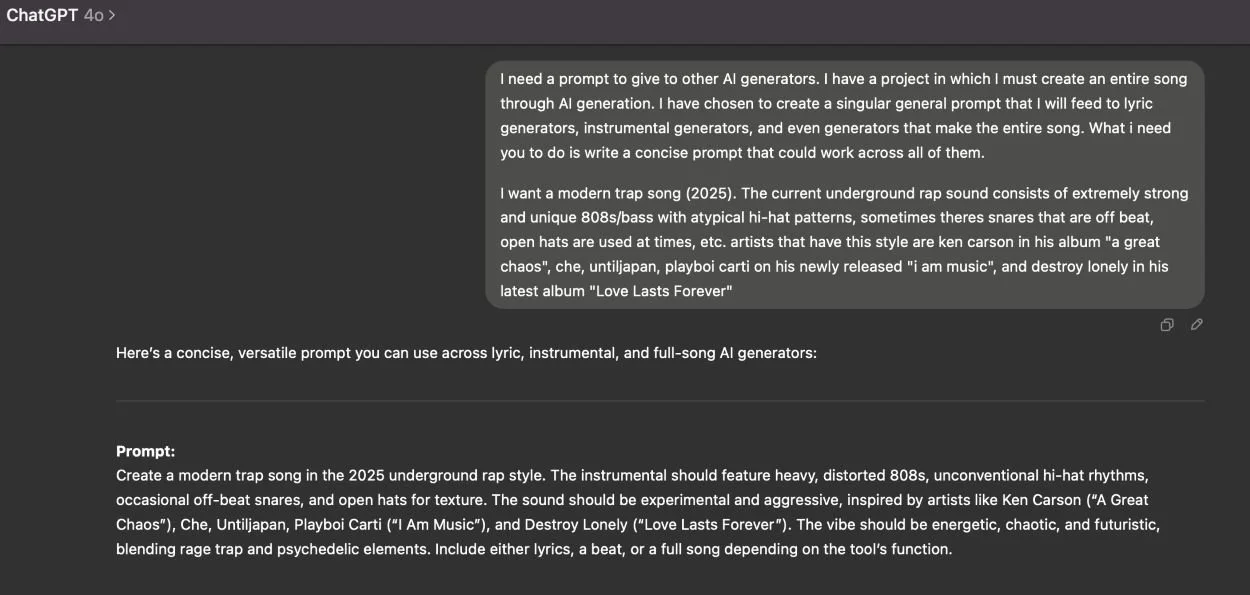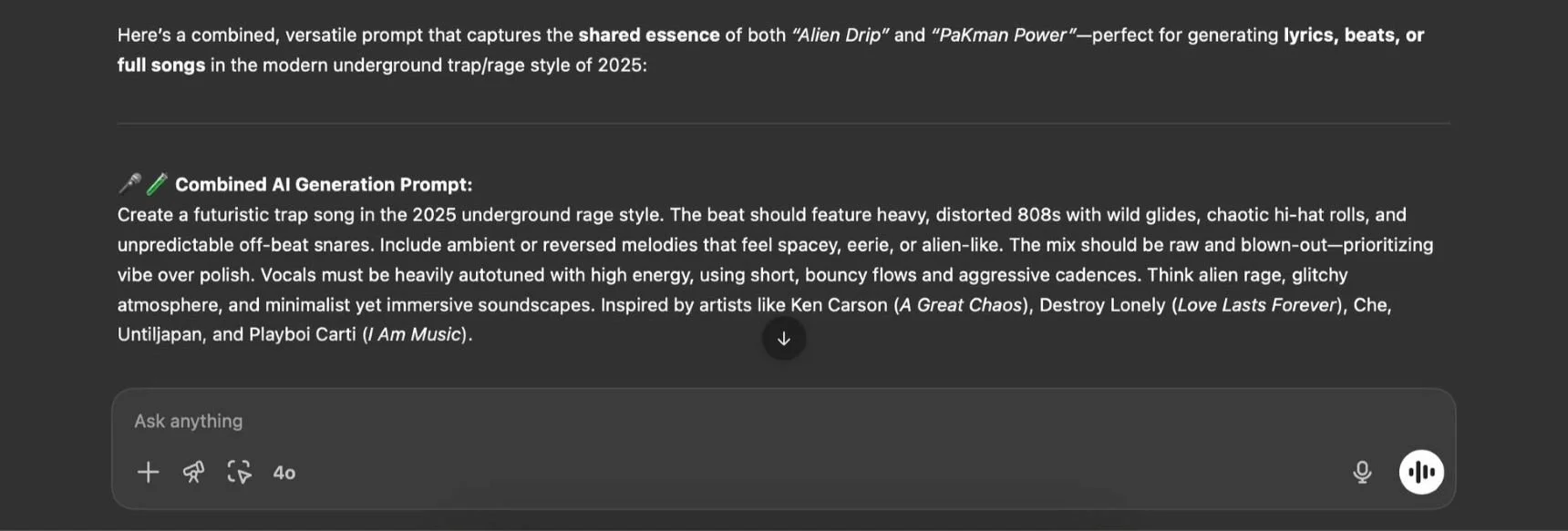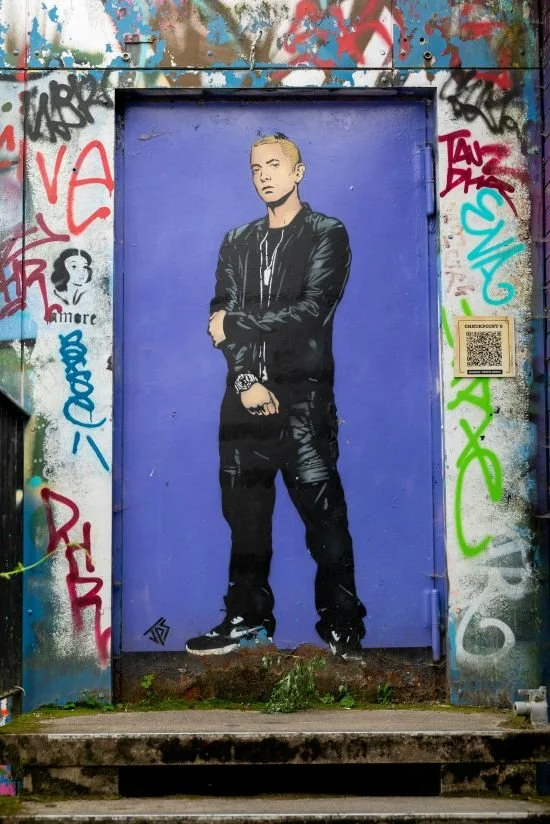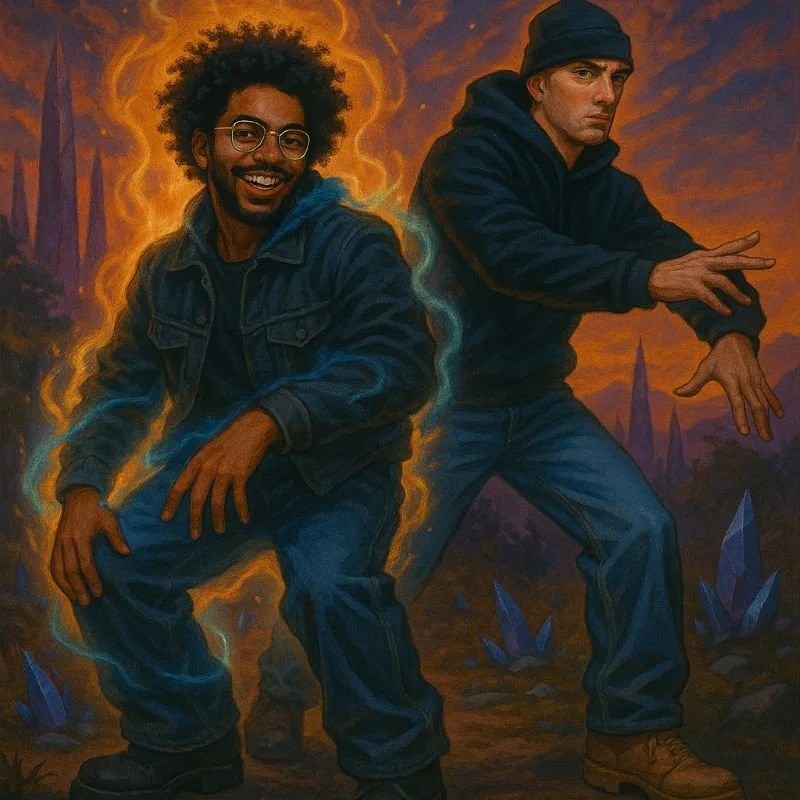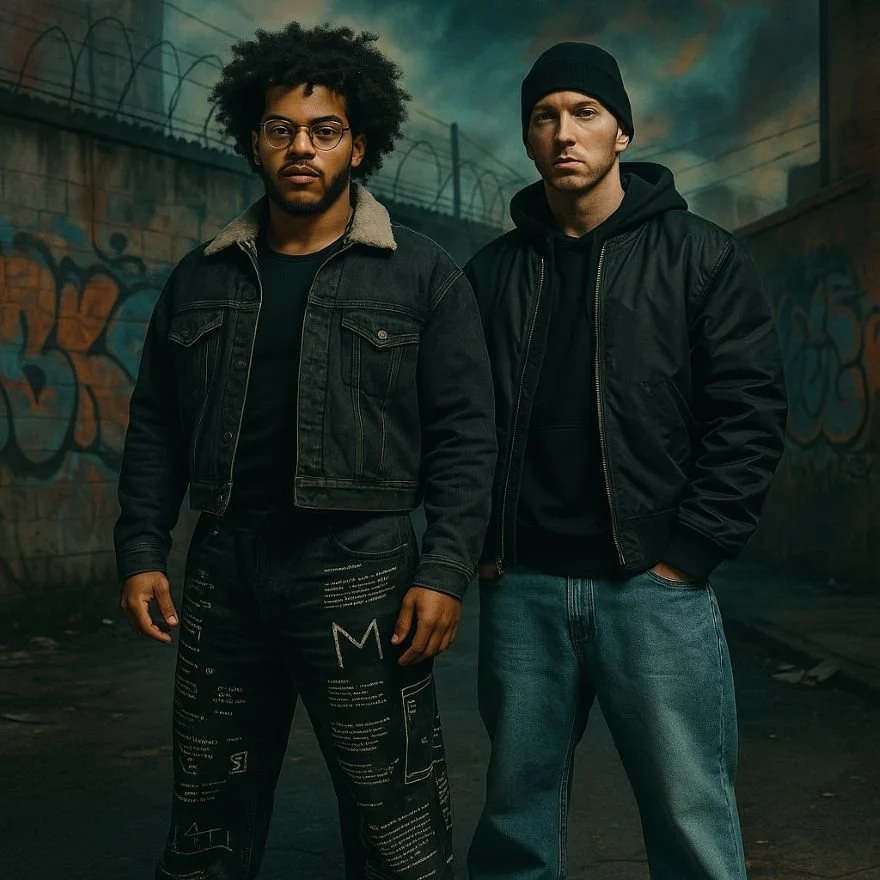Creating an AI-Generated Trap Song
〰️ Robeezy
〰️ Eminem
〰️ Robeezy 〰️ Eminem
Art, writing, and filmmaking are just a few of the creative disciplines that are changing due to the use of AI technology. But music — especially trap and underground hip hop — has a unique relationship to rhythm, voice, and authenticity that raises serious questions regarding automation. Can a machine mimic this sound’s grit, messiness, and swagger?
What would happen if an entire song is generated with AI, including beat, lyrics, and vocals? I explored this question by combining the aesthetics of underground trap music with generative tools to examine both artistic possibilities and legal and ethical issues. Here is the final result.
Initial Prompt Engineering
I asked ChatGPT for a universal prompt that could be used in multiple AI music tools, such as lyric generators, instrumental generators, and full-song generators. The aim was to keep a consistent style across all elements of the track.
I later fed ChatGPT two of my own tracks, Alien Drip and PaKman Power, to better refine the style. Based on those, a second prompt was generated:
A shortened version was created for tools with a 200-character limit to suit input restrictions:
”Futuristic rage trap with blown-out 808s, glitchy FX, off-beat snares, spacey ambient melodies, chaotic hi-hats, and aggressive autotuned vocals. Inspired by Carti, Ken Carson, Che, Untiljapan.”
AI Tool Analysis
I tried several different AI music generators. As the generations grew, it became very clear that the first prompts became very distorted, which shows that the user input is not always interpreted the same way across the board. All the AI music generator tools had both advantages and disadvantages, listed below, which showed the unstable nature of AI music-making. Listen to some examples of the music generated using these tools.
-
Strengths
Creates full songs (lyrics, melody, drums); beats closely match desired trap sound; reliable.
Weaknesses
Vocals sound generic; Caucasian-sounding voice; EDM-inspired transitions.
Approx. Generations
14
Notes
Strongest all-around performance.
-
Strengths
Lyrics are at least intelligible.
Weaknesses
Robotic voice, distorted/compressed output, extremely basic, can’t save prompts, limited free usage.
Approx. Generations
~10
Notes
Least useful overall.
-
Strengths
Closest match in instrumentals; high energy; unpredictable structure (“ADHD music”).
Weaknesses
Used female voice despite male request; some generations drifted into EDM territory.
Approx. Generations
23
Notes
Best instrumental match early on.
-
Strengths
Electric guitar aligned with my vision; some usable beats.
Weaknesses
Predictable vocal flow; lacks trap aggression; EDM-heavy.
Approx. Generations
8
Notes
Decent instrumentals but lacks trap essence.
-
Strengths
Generates quickly; some tracks had clean instrumentation.
Weaknesses
Ignores prompts; inserts “Mubert” tag; sounds like Fortnite/EDM music.
Approx. Generations
8
Notes
Instrumentals were off-genre and unusable.
-
Strengths
N/A
Weaknesses
Generated tracks sounded like retro video game music (e.g., Mario 64); irrelevant to trap genre.
Approx. Generations
~3–4
Notes
Completely off-mark.
Here’s a generation from Beathoven.ai that reminded me of Super Mario 64
Revised Approach: Human-AI Collaboration
An entirely AI-made song didn’t impress much, so I used a hybrid instead. I chose a UDIO beat (Chaos Theory Ext v1.2) and extended the beat using the audio variations in the platform. Then, I recorded vocals in GarageBand. In my search for a lyric generator, I found that most came with audio and text, meaning that they were limiting and nothing could ever be modified in a meaningful way.
This switch was arguably the biggest transformative moment of the process. It shifted from merely testing the technology to actually co-creating it. I was able to get sonic fidelity that felt real (not merely experimental) through the blend of structured AI outputs and instinctive editing.
The Recording Process
Starting with Apple’s built-in music creation software GarageBand. I imported Chaos Theory Ext v1.2 into the first audio track and began brainstorming lyrics. My first attempts used “punch-in” style recording, where I laid down a few bars at a time.
This request generated a surprisingly solid verse. The flow, aggression, and structure were significantly better than expected. I wanted to use these lyrics to make another verse and put it to a voice model of AI Eminem. The result sounded so good that I decided to throw the original recording out altogether and use the new lyrics entirely since there wasn’t enough beat time. I did these lyrics in one take, extracted my raw vocals from Garage Band and fed them into Musicify.lol to process them through an Eminem AI voice filter.
If you notice during the video, I specify that there is an “Eminem verse.” Eventually, I returned to ChatGPT and used the following prompt:
“Create some lyrics for an Eminem song, 142 bpm.”
I then layered the processed vocals back into GarageBand, editing and combining both the AI and original voice tracks to finalize the song. This editing process required slicing the verses, adjusting timing, and messing around with the equalizer for clarity.
Legal and Ethical Considerations in AI-Generated Music
As generative AI becomes more popular in music creation, new legal and ethical issues arise relating to copyright, publicity rights, and fair use.
1. Copyrightability of AI-Generated Works
According to the U.S. Copyright Office, “Copyright does not extend to purely AI-generated material, or material where there is insufficient human control over the expressive elements” (Copyright and Artificial Intelligence, 2025). But a portion of the work that is a “derivative” or “compilation” with human authorship may be protected when a human makes creative choices like selection of prompts, editing of lyrics, arrangement, and mixing of elements, etc.
How this applies to my AI song: Since I chose the beat, sculpted the prompts and script, edited the lyrics, and layered and mixed my own vocals, I am likely to have copyrightable content.
2. Voice Imitation and the Right of Publicity
AI copies of someone's voice—like Eminem's voice—might infringe their right of publicity. This is the right of a person to exploit their name/image commercially. This is especially true in states like California and Tennessee, which include laws that expressly prohibit digital impersonations of performers without permission.
Tennessee passed the “ELVIS Act” in 2024, making it illegal to use AI to impersonate a performer’s voice without permission, even in digital media (RIAA, 2024).
How this applies to my AI song: While my AI song is not intended for commercial uses, if the song with the Eminem AI voice filter were posted on a streaming service like Spotify, it could raise legal issues, especially if it goes viral or on social media. In a commercial setting, this would likely require Eminem’s permission.
3. Training Data Transparency and Derivative Use
There are many generative music platforms (like Suno and Udio) that have been accused of using licensed data as training. In 2024, the RIAA sued both companies for allegedly training their AI models on copyrighted music, a violation of the exclusive rights of reproduction and derivative use under 17 U.S. Code § 106 (RIAA Lawsuit, June 2024).
How this applies to my AI song: The beat from UDIO that I used can potentially infringe on a copyrighted song it was trained on.
4. Fair Use and Transformative Value
Some people argue that AI content is fair use because it transforms copyrighted work to add new expressions and meaning. Courts consider four elements when analyzing fair use: the purpose of the use, the nature of the work, the amount used, and its effect on the market for the copyrighted item (University of Louisville). A simple remix or re-filteration of an existing style, such as Eminem’s voice, may not be sufficiently transformative to qualify for fair use, and even more so in a commercial context.
How this applies to my AI song: My AI song is for educational purposes, noncommercial, and mostly consists of original arrangement and editing, so the fair use defense may apply.
See more expert interviews and information about AI here.
Reflection
Though there were problems at first, I was pleasantly surprised with the end result. The final result is made of several AI instruments, AI-written lyrics, and AI-processed vocals. I was shocked that by giving in to the creative collaboration between human and machine, I found it to be a fun process.
Still, my conclusion is that AI can’t create good music on its own. Many outputs were lacking in genre fidelity, vocal nuance, or sonic consistency, even if some tools were promising. EDM sounds and robot voices were common, and customization is limited on all platforms. True creativity still demands human direction, in my opinion.
While the final song exceeded my expectations, I wouldn’t consider it good, and I can’t imagine choosing to listen to it voluntarily in my free time.
References
Connelly, Rose. “Record Companies Bring Landmark Cases for Responsible AI Against Suno and Udio in Boston and New York Federal Courts, Respectively.” RIAA, 24 June 2024, https://www.riaa.com/record-companies-bring-landmark-cases-for-responsible-ai-againstsuno-and-udio-in-boston-and-new-york-federal-courts-respectively/.
Fair Use Four Factor Analysis — Copyright Guidelines and Resources. https://louisville.edu/copyright/resources/four-factor-analysis.
Leibfreid, Megan. “ELVIS Act Becomes Law as Tennessee Leads the Nation.” RIAA, 22 Mar. 2024, https://www.riaa.com/elvis-act-becomes-law-as-tennessee-leads-the-nation/.
Office, U. S. Copyright. “Copyright and Artificial Intelligence.” U.S. Copyright Office, https://www.copyright.gov/ai/.

